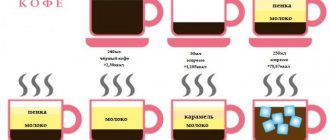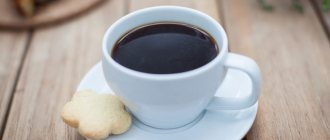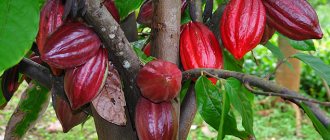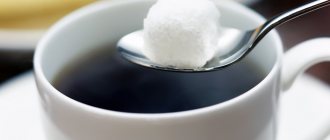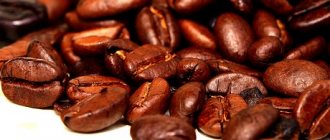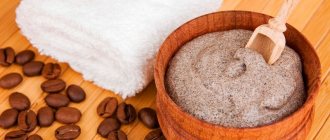Calorie content of 100 g of coffee
The calorie content of a sugar-free coffee drink is influenced by many factors. In terms of nutritional value, natural beans and instant coffee will be completely different. This indicator also differs in the decaffeinated type and with flavorings.
Instant drink
Instant coffee contains a minimum amount of sugars, acids and fats. When making this drink, they are simply washed away. The percentage of natural raw materials in these products is up to 15% of the total mass. The rest comes from chemical additives that create color and odor. Therefore, instant coffee is higher in calories than natural coffee without sugar.
Calculating how many calories are in instant coffee without sugar is not difficult if you take the figure 6 kcal per 100 g in finished form. This figure is appropriate for the granulated form, but in the freeze-dried form it doubles and amounts to 12 kcal. Nutritional value will also depend on the brand of the product.
In the table you can study the main indicators of products from well-known manufacturers:
| Brand | Calorie content per 100 grams | Kilocalories per teaspoon |
| Nescafe Classic | 56 | 5,6 |
| Carte Noire | 100 | 10 |
| "Egoist" | 90 | 9 |
| Jacobs Monarch | 100 | 10 |
| Maxwell House | 100 | 10 |
| Tchibo Exclusive | 264 | 26,4 |
| Jardin | 92 | 9,2 |
Natural black coffee
The grain drink includes proteins, glucose and fats. The concentration of these substances will depend on the date of roasting. The closer it is, the higher their content. When grains are stored for a long time, these components begin to gradually evaporate. A minimum of them remains in the ground grains, which are stored in a loosely closed jar. Therefore, if you grind the roasted beans and brew coffee immediately, then the mug will contain 1-2 more calories. Also, calorie content has a direct relationship with the duration of extraction. If you brew ground coffee beans in a Turk, then 200 ml will contain 4 kcal. If the same volume of drink is prepared in a French press, the calorie content will be 3 kcal.
Cafein free
The caffeine-free drink is considered dietary and the lowest in calories. But it will be like this if the correct decaffeination technique is chosen. In this case, the calorie content of the standard volume will be only 1 kcal for whole grains. If you brew soluble granules without sweeteners and dairy products for 1 glass, the value will increase to 15 kcal.
With flavors
Flavorings consist of sugars and fats that make the substance more nutritious for the body. Any flavorings increase the calorie content of coffee by at least 2 times. Chocolate, cherry, nut flavors are estimated at 8 kcal.
Content of vitamins and macroelements
Roasted grains have a huge amount of vitamins necessary for the body, these include: calcium, sodium, iron, sulfur, nitrogen, phosphorus. There are two main elements present in coffee beans: caffeine and trigoneline. The invigorating effect on the body and the aroma of the product itself depend on these elements.
Coffee beans, interacting with high temperatures, form nicotinic acid and have a beneficial effect on the functioning of the body as a whole. Roasted beans contain sucrose, which, when fried, forms caramel, which is why the drink acquires a dark brown tint.
Varieties of coffee
For each specific type of coffee drink, the number in the calorie table will be individual.
There are these types:
- latte, the recipe for which is simple. Espresso is taken, milk and milk foam are added to it. The standard volume contains 250 kcal,
- mocaccino is prepared similarly to the previous type, but with the addition of chocolate. Its nutritional value, accordingly, increases to 289 calories,
- cappuccino - a coffee drink with the addition of milk, cream, and optionally sugar, on the surface with voluminous milk foam, value 211 kcal,
- Mocha is also prepared using espresso, as well as milk and chocolate in equal proportions. Once cooked, whipped cream is added on top. Calorie content of one standard mug is 260 kcal,
- glacier - with the addition of ice cream. If these are natural grains and ice cream, then its nutritional value is 155 kcal,
- Irish - espresso with alcohol and whipped cream on top, 120 calories,
- Romano is a combination of a standard shot of espresso and lemon juice with a value of only 4 kcal.
Tannin
Raw grains contain quite a lot of tannin - 4-7%. But after roasting, its concentration decreases. Only about 1% or less remains in the finished grains. Tannin is highly susceptible to oxidation. Already under the influence of 80 degrees, its transformation begins. By the way, it is due to the oxidation of tannin that coffee beans acquire a pleasant brown tint during roasting. It is formed by dark pigments resulting from the oxidation of tannin. Scientists don't think so. That the destruction of tannin negatively affects the characteristics of coffee. On the contrary, it is this process that leads to the fact that coffee acquires its characteristic taste and shade. But if the grains are heated too much, the tannin will completely decompose. This is why some coffee beans give off an unexpressed, empty taste later. This means that the beans were not roasted correctly and the tannin was completely destroyed.
Nutritional value of coffee additives
To determine how many calories are in coffee, you need to take into account the energy value of the ingredients. By itself, the calorie content of black coffee without sugar is low, but depending on the additives in the recipe, it can increase several tens of times.
Sugar
Espresso in its standard serving with 1 spoon of sugar has a value of 22 kcal. Some believe that if you add a sweetener instead of sugar, you can significantly reduce the nutritional value of your favorite drink. However, many simply do not know that the difference between them is almost insignificant - 4 kcal.
Whole milk
Whole milk is rich in all essential food components such as carbohydrates, proteins and fats. In 1 tbsp. l. milk can have a different number of calories depending on its fat content: from 9 to 12. If you use powdered milk to make coffee, this will add 12 calorie points to it. If you take a soy product, then in 1 tbsp. l. will be 6 kcal.
Skimmed milk
This dairy product contains virtually no fat. 1 tbsp. l. milk is rated on the food scale at 7 kilocalories. If you add it to a mug of espresso, it will only have 9 kilocalories.
Practical advice: Despite its low calorie content, skim milk is rich in vitamins, microelements, and amino acids. Therefore, choosing it will be the right choice for people who are on a diet or living according to the rules of a healthy diet.
Cream
Coffee creamer is one of the most common and sought after additives. In 1 tbsp. l. There may be a different amount of kcal depending on the fat content of the product:
- 10% – 15,
- 20% – 25,
- 30% – 50.
Condensed milk
One of the most nutritious and satisfying additions to coffee is condensed milk. 1 tablespoon contains a whopping 36 calories. There is a type of condensed milk that does not contain sugar. It contains 2.5 times less calories.
Natural coffee, brewed from roasted coffee beans, without sugar, sweeteners and all kinds of additives, is a low-calorie, tasty drink. If you dilute its taste with cream, milk, chocolate or even sugar, the nutritional value of coffee will increase significantly. This indicator should be closely monitored by people who are on a diet, trying to get rid of extra pounds, and maintaining their health level.
Green grains
Green coffee is becoming more and more popular day by day, despite the fact that it is not cheap. At the same time, there are both supporters and opponents. The former consider it a drink endowed with healing properties, while the latter generally recommend staying as far away from it as possible. In reality, these are just contradictions.
Beans that have not been roasted contain a large amount of antioxidants and valuable microelements. Thus, a thermally untreated product contains a lot of:
- Caffeine. It is this that gives coffee its invigorating and tonic effect. There is also another alkaloid, theobromine, which is able to regulate the concentration of glucose in the blood.
- Tannin. It is a tannin with antibacterial properties that helps remove heavy toxins from the body. It also helps strengthen blood vessels, improve digestion and speed up the process of tissue regeneration.
- Chlorogenic acid. An effective antioxidant of plant origin, which is found only in raw grains, since temperatures of 200-250°C (roasting) lead to its destruction. Thanks to its presence in coffee beans, fats do not accumulate in the body, metabolism improves, and the functioning of the digestive and circulatory systems returns to normal.
- Theophylline. The composition of the blood improves, which reduces the risk of blood clots. Also responsible for normalizing the functioning of the respiratory system, abdominal cavity, and heart.
- Amino acids. Our immunity increases its protective functions, the tone of the vascular system increases, and our appetite returns to normal. In addition, a person can gain the required amount of muscle mass.
- Lipids. These substances have a beneficial effect on the nervous system.
- Fiber. If there is a sufficient amount of these substances in the body, then the risk of developing cancer can be avoided. Cholesterol levels are well controlled, in addition, digestion and the functioning of the pelvic organs are normalized.
- Trigonelline. Thanks to it, blood pressure returns to normal, metabolism is maintained at an optimal level, brain function and the formation of blood cells improve.
- Essential oils. They act as a sedative, help improve digestion, and have a beneficial effect on the respiratory system. But most importantly, the substances can eliminate harmful microorganisms.
It is worth noting that theobromine in coffee beans is a kind of analogue of caffeine. As you can see, unprocessed grains have more beneficial properties. It is no coincidence that it is recommended to consume green grains for weight loss.
Is there any harm?!
Despite all the benefits that coffee beans provide, this composition can also cause harm. Over time, addiction appears - if a person goes without coffee for a long time, he becomes drowsy, tired, gets a headache, and in some cases, pain may appear in the muscles.
At the same time, the influence is not only on the physical, but also on the mental level. While caffeine is present in the body, a person spends most of his time in an excited state. But in its absence, one cannot avoid the appearance of irritability, depression, and even lethargy.
Coffee helps strengthen the functioning of the human heart and vascular system. Therefore, excessive consumption of the drink leads to an inevitable deterioration in cardiac activity.
In addition, it has a good diuretic effect, and taking it too often leads to rapid aging of the body as a whole, since most useful microelements are washed out along with water and salts. Among them are calcium and magnesium. If they are clearly deficient, the risk of osteoporosis or heart disease increases.
Pregnant women should not consume coffee beans at all. The composition acts on an unborn baby in the same way as on an adult. But for addiction to appear, a very small dose is required, so it is better for expectant mothers to completely abstain from this drink.
